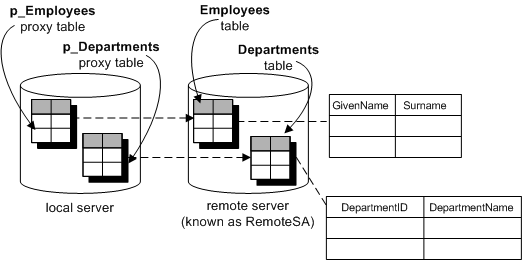The following figure illustrates proxy tables on a local database server mapped to the remote tables Employees and Departments of the SQL Anywhere sample database on the remote server RemoteSA mapped.

You can use joins between tables on different SQL Anywhere databases. The following example is a simple case using just one database to illustrate the principles.
 To perform a join between two remote tables (SQL)
To perform a join between two remote tables (SQL)Create a new database named empty.db.
This database holds no data. It is used only to define the remote objects, and to access the SQL Anywhere sample database.
Start a database server running the empty.db. You can do this using the following command line:
dbsrv12 empty |
From Interactive SQL, connect to empty.db as user DBA.
In the new database, create a remote server named RemoteSA. Its server class is saodbc, and the connection string refers to the SQL Anywhere 12 Demo ODBC data source:
CREATE SERVER RemoteSA CLASS 'saodbc' USING 'SQL Anywhere 12 Demo'; |
In this example, you use the same user ID and password on the remote database as on the local database, so no external logins are needed.
Sometimes you must provide a user ID and password when connecting to the database at the remote server. In the new database, you could create an external login to the remote server. For simplicity in our example, the local login name and the remote user ID are both DBA:
CREATE EXTERNLOGIN DBA TO RemoteSA REMOTE LOGIN DBA IDENTIFIED BY sql; |
Define the p_Employees proxy table:
CREATE EXISTING TABLE p_Employees AT 'RemoteSA..GROUPO.Employees'; |
Define the p_Departments proxy table:
CREATE EXISTING TABLE p_Departments AT 'RemoteSA..GROUPO.Departments'; |
Use the proxy tables in the SELECT statement to perform the join.
SELECT GivenName, Surname, DepartmentName FROM p_Employees JOIN p_Departments ON p_Employees.DepartmentID = p_Departments.DepartmentID ORDER BY Surname; |
 |
Discuss this page in DocCommentXchange.
|
Copyright © 2010, iAnywhere Solutions, Inc. - SQL Anywhere 12.0.0 |